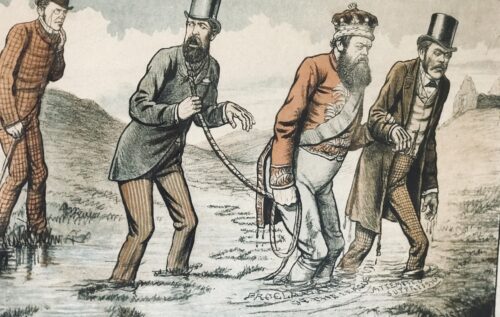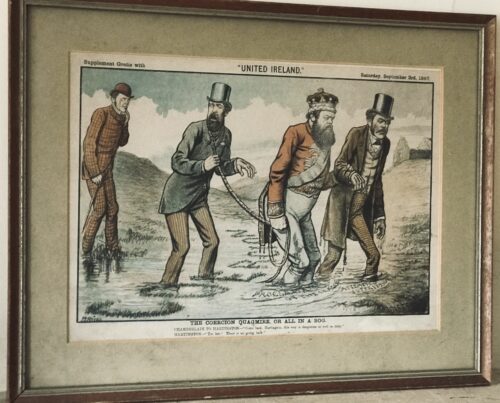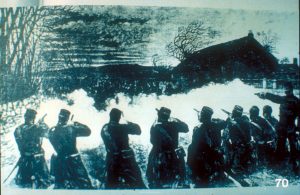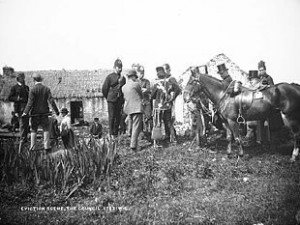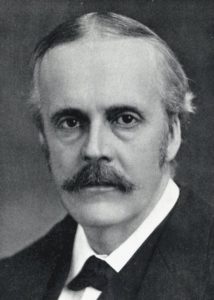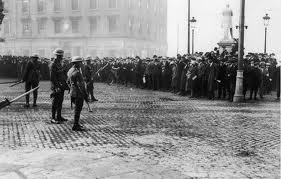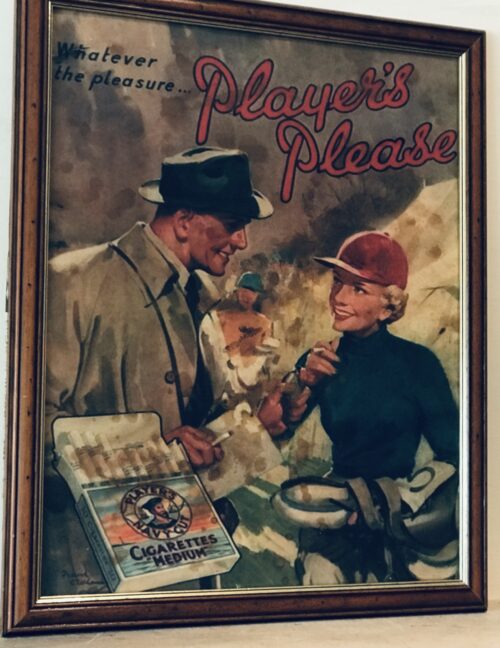55cm x 45cm Doneraile Co Cork
Classic Players Please Navy Cut advertising showcard depicting the great Triple Crown Winner Ormonde.
Ormonde (1883–1904) was an English
Thoroughbred racehorse who won the
English Triple Crown in 1886 and retired undefeated. He also won the
St. James's Palace Stakes,
Champion Stakes and the
Hardwicke Stakes twice. At the time he was often labelled as the 'horse of the century'. Ormonde was trained at
Kingsclere by
John Porter for the
1st Duke of Westminster. His regular jockeys were
Fred Archer and
Tom Cannon. After retiring from racing he suffered fertility problems, but still sired
Orme, who won the
Eclipse Stakes twice.
Background
Ormonde was a bay
colt, bred by
Hugh Grosvenor, 1st Duke of Westminster and foaled in 1883 at Eaton Stud in
Cheshire. Ormonde's sire was
The Derby and
Champion Stakes winner
Bend Or, also bred by the Duke. Bend Or was a successful stallion, his progeny included
Kendal,
Ossory, Orbit, Orion, Orvieto,
Bona Vista and Laveno.
Ormonde's dam was
Doncaster Cup winner
Lily Agnes. She was sired by another Derby winner,
Macaroni. Lily Agnes began to experience problems with her lungs as a four-year-old, to the extent that jockey John Osborne said he could hear her approaching before he saw her. The problem did not interfere with her racing ability as she continued to win at four and five. She then became a top broodmare also foaling
1000 Guineas winner Farewell, Ormonde's full-brother
Ossory and another full-brother Ornament, who produced the outstanding
Sceptre, the only racehorse to win four
British Classic Races outright.
Ormonde was born at half-past six in the evening of 18 March 1883. The Duke's stud-groom Richard Chapman stated that for several months after foaling, Ormonde was
over at the knee. Chapman later said he had never before or since seen a horse with the characteristic so pronounced and that it had seemed impossible for him to ever grow straight. Ormonde did gradually grow out of the problem though and by the time he left the stud to go into training at
Kingsclere, trainer
John Porter told the Duke he was the best yearling the Duke had sent him. However during the winter of 1884/85, Ormonde had trouble with his knees. The treatment he received for this held his training back considerably, with him only having easy cantering exercises until the summer of 1885.
Ormonde grew into a well-built horse standing 16
hands (64 inches, 163 cm) with excellent bone and straight hocks. Porter later said his neck "was the most muscular I ever saw a Thoroughbred possess." He had an excellent shoulder and short powerful hindquarters that led some to call him a racing machine. When galloping, he held his head low and had a notably long stride. He had a kind temperament, healthy appetite and strong constitution. Porter stated the horse was fond of flowers and would even eat the
boutonniere from the jacket of anyone within reach.
Racing career
1885: Two-year-old season
Prior to his racecourse debut, Porter ran Ormonde in a trial against
Kendal, Whipper-in and Whitefriar. Kendal, carrying one pound less, won the trial by a length from Ormonde. Kendal had already had a number of races by this point and Ormonde was nowhere near fully fit. By this point he stood 16 hands high and had a very muscular neck and strong back. Porter also noted that when extended, Ormonde had a very long stride. The Duke rode him in a couple of canters and remarked
"I felt every moment that I was going to be shot over his head, his propelling power is so terrific."
As a two-year-old, Ormonde did not race until October when he won the Post Sweepstakes race at
Newmarket. He started at 5/4 with the filly Modwena, who had won eight races out of ten that year, the 5/6 favourite. In the heavy going, Ormonde went on to win by a length from Modwena. Ormonde's next racecourse appearance came in the Criterion Stakes, again at Newmarket, where his opposition included Oberon and Mephisto. Starting at 4/6, Ormonde won easily by three lengths from Oberon, with Mephisto a distant third.
He then started the
Dewhurst Plate as the 4/11 favourite, ridden by
Fred Archer. After an even start, Ormonde was positioned just behind the leader. As they neared the closing stages, Archer let Ormonde go and he quickly pulled away from the field to beat his stablemate, Whitefriar, easily by four lengths.
The field also included
Miss Jummy, who went on to win the
1000 Guineas and
Epsom Oaks. These three victories earned him £3008. 1885 was considered to have had the best group of two-year-olds for many years.
1886: Three-year-old season
Going into the 1886 season, Ormonde was one of the favourites for the
Derby. He was priced at 11/2, similar to
Minting, Saraband and
The Bard.
2000 Guineas
Ormonde started off his three-year-old campaign in the
2000 Guineas at
Newmarket. The race was considered a clash between Ormonde, the unbeaten
Middle Park winner
Minting and Saraband. In a small field of six, Minting was sent off the 11/10 favourite, Saraband at 3/1 and Ormonde at 7/2. This time Ormonde was ridden by
George Barrett, with Fred Archer riding Saraband. The horses ran almost in line in the early stages. Saraband began to struggle and was beaten with two furlongs to run. At this point Ormonde and Minting took over the lead from St. Mirin. Ormonde then went on to record as easy 2 length victory over Minting, with Mephisto a further 10 lengths back in third, who in turn was two lengths ahead of Saraband.
The Derby
After his Newmarket performance, Ormonde was the favourite for the
Derby with Fred Archer back as his jockey. A small field of 9 went to post, with Ormonde the 40/85 favourite and his main opposition,
The Bard, at 7/2 who. The Bard was also undefeated and had won many races as a two-year-old. The start was not even, with outsider Coracle almost 6 lengths clear of Ormonde, who was a similar distance clear of the rest. Ormonde and The Bard took over the lead at Tattenham corner and the two raced up the straight. The Bard got a neck in front, but when Archer asked Ormonde for an effort, he pulled in front to win by 1½ lengths from The Bard, with St. Mirin a further 10 lengths back in third.
Royal Ascot
At
Royal Ascot against just two opponents, Ormonde lined up as the 3/100 favourite for the
St. James's Palace Stakes. He won easily by ¾ length from Calais. Three days later he faced a stronger field in the
Hardwicke Stakes including 1885
Derby and
St Leger winner
Melton. Ormonde, the 30/100 favourite, won easily again though, beating Melton by 2 lengths. He then had a break from the racecourse.
After Ascot Ormonde was already as short as 1/2 for the St Leger.
Autumn
While Ormonde was galloping one morning shortly before the
St Leger Stakes, Porter noticed him making a whistling noise.
In spite of this infirmity, Ormonde started the final classic of the year as the 1/7 favourite. Ridden again by Archer, he pulled away half a mile out and won easily by 4 lengths from St. Mirin, without even being asked for an effort.
The win made him the fourth winner of the English Triple Crown.
He next ran in the Great Foal Stakes at Newmarket, again winning easily by three lengths from Mephisto.
[13] He then won the Newmarket St Leger in a walkover
and the
Champion Stakes as the 1/100 favourite by a length from Oberon.
Ormonde then entered a free handicap at
Newmarket. Starting the 1/7 favourite and carrying 9 st 2 lb, he won by eight lengths from Mephisto, to whom he was conceding 28 lbs. At the same meeting he won a private sweepstakes in a walkover.
The sweepstakes was an originally scheduled as a match race between Ormonde, The Bard, Melton and possibly Bendigo, the 1886 Eclipse winner. Bendigo was not nominated from the race in the end. The Bard and Melton were though and both forfeited £500 to Ormonde's connections. Throughout the end of the season, Ormonde's breathing had become progressively louder until he was labelled a
roarer.
1887: Four-year-old season
Ormonde did not race until June 1887. His return was assisted by an experimental treatment involving "galvanic shocks" being applied daily to his chest and throat.
His reappearance came at
Royal Ascot in the
Rous Memorial Stakes, where his opposition included Kilwarlin, who went on to win the season's
St. Leger Stakes. Ormonde was conceding 25 pounds to Kilwarin and before the race Kilwarin's owner
Captain Machell said to Porter, "The horse was never foaled that could give Kilwarin 25 pounds and beat him." After
Fred Archer's suicide,
Tom Cannon was now Ormonde's jockey. He led the race throughout and won easily by six lengths from Kilwarlin, with Agave a distant third.
Upon seeing Captain Machell in the paddock after the race Porter said, "Well, what did you think of it now?" Machell replied, "Ormonde is not a horse at all; he's a damned steam-engine."
He raced again the next day in the
Hardwicke Stakes, where he faced a strong field including
Minting and
Eclipse Stakes winner Bendigo. Minting's trainer
Matt Dawson was confident that his horse could win this time due to Ormonde's breathing problems. As the four runners made their way to the starting post he remarked to Porter "You will be beaten today, John. No horse afflicted with Ormonde's infirmity can hope to beat Minting."
Indeed, Porter himself admitted he was not overly confident of victory. During the race
George Barrett, aboard Phil, impeded Ormonde and he was made to struggle for the first time in his career. During the closing stages, Ormonde and Minting battled with each other and Ormonde just came out on top, winning by a
neck, with Bendigo in third.
In his final race, he won the 6 furlong
Imperial Gold Cup at
Newmarket. Starting at 30/100 he made all the running and won by two lengths from Whitefriar.
Ormonde was then retired as the most celebrated horse of his era. He was sent by train to Waterloo Station, then walked to
Grosvenor House in
Mayfair, where he was the guest of honor at a garden party to celebrate
Queen Victoria's
Golden Jubilee.
Race record
Assessment
Ormonde is generally considered one of the greatest racehorses ever. At the time he was often labelled as the 'horse of the century'.
His achievements are even more impressive considering the strength of some of the other horses foaled in 1883. It is said that both
Minting and
The Bard were good enough to have won
The Derby nine out of ten years.
In early 1888 Minting, the horse Ormonde beat easily in the 2000 Guineas, was rated 15 pounds superior to the 1887 Derby winner
Merry Hampton and the 1887
St Leger winner Kilwarlin.
Stud record
Ormonde went to the Duke of Westminster's Eaton Stud in 1888, where he sired seven foals from the sixteen mares he covered, including Goldfinch and
Orme. In 1889, he was moved to Moulton Paddocks in Newmarket, but became sick and could only cover a few mares, with only one live foal produced in 1890. He was subsequently returned to Eaton Stud but his fertility never recovered. To the astonishment of many, Ormonde was then sold overseas. Both he and his dam were roarers, and the Duke felt this could weaken English bloodstock.
Ormonde was sold to Senor Bocau of Argentina for £12,000,
and then in 1893 to William O'Brien Macdonough, of California for £31,250. He stood at the Menlo Stock Farm in California for several years, where he sired 16 foals.
including
Futurity Stakes winner Ormondale.
English foals
c = colt, f = filly
| Foaled |
Name |
Sex |
Notable wins |
Wins |
Prize money |
| 1889 |
Goldfinch |
c |
Biennial Stakes, New Stakes |
2 |
£2,464 |
| 1889 |
Kilkenny |
f |
|
1 |
£164 |
| 1889 |
Llanthony |
c |
Ascot Derby |
4 |
£3,139 |
| 1889 |
Orme |
c |
Middle Park Plate, Dewhurst Plate, Eclipse Stakes (twice), Sussex Stakes, Champion Stakes, Limekiln Stakes, Rous Memorial Stakes, Gordon Stakes |
14 |
£32,528 |
| 1889 |
Orontes II |
f |
|
0 |
|
| 1889 |
Orville |
c |
|
0 |
|
| 1889 |
Sorcerer |
c |
|
1 |
£229 |
| 1890 |
Glenwood |
c |
Aylesford Foal Plate |
2 |
£1,726 |
Despite only siring eight horses in England, Ormonde had a signficant impact at stud. Orme was the
leading sire in Great Britain and Ireland when he sired another Triple Crown winner,
Flying Fox, who went on to be a leading sire in France. Orme also sired
Epsom Derby winner
Orby and
1000 Guineas winner
Witch Elm. Goldfinch sired 1000 Guineas winner Chelandry. After being sold and moving to
California, Goldfinch sired
Preakness Stakes winner
Old England. In America, his son Ormondale went on to sire
Jockey Club Gold Cup winner
Purchase.
Ormonde died in 1904 at age 21 at Rancho Wikiup in
Santa Rosa, California. His disarticulated skeleton/skull were later returned to the
Natural History Museum in
South Kensington,
London.
His male line survives mainly through
Teddy, grandson of Flying Fox. Orby does still have a sire line as well.
Ormonde may have been the model for the fictional horse Silver Blaze in
Arthur Conan Doyle's
Sherlock Holmes short story "
The Adventure of Silver Blaze" (1892).










